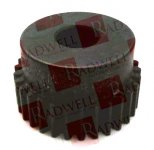steve45
Stainless
- Joined
- Jan 16, 2012
- Location
- Midland, Texas
I found some change gears for my lathe so I can cut metric threads. Correct pressure angle, teeth, etc. but they are a little too thick and the bores need to be enlarged to fit, and keyways need to be cut in them.
The gears are hardened, so my question is how to proceed? Should I try to anneal them with the O-A torch, then try to re-heat treat them? (Never done it before). Is this something I should take to a professional machine shop?
Your thoughts would be appreciated!
The gears are hardened, so my question is how to proceed? Should I try to anneal them with the O-A torch, then try to re-heat treat them? (Never done it before). Is this something I should take to a professional machine shop?
Your thoughts would be appreciated!



